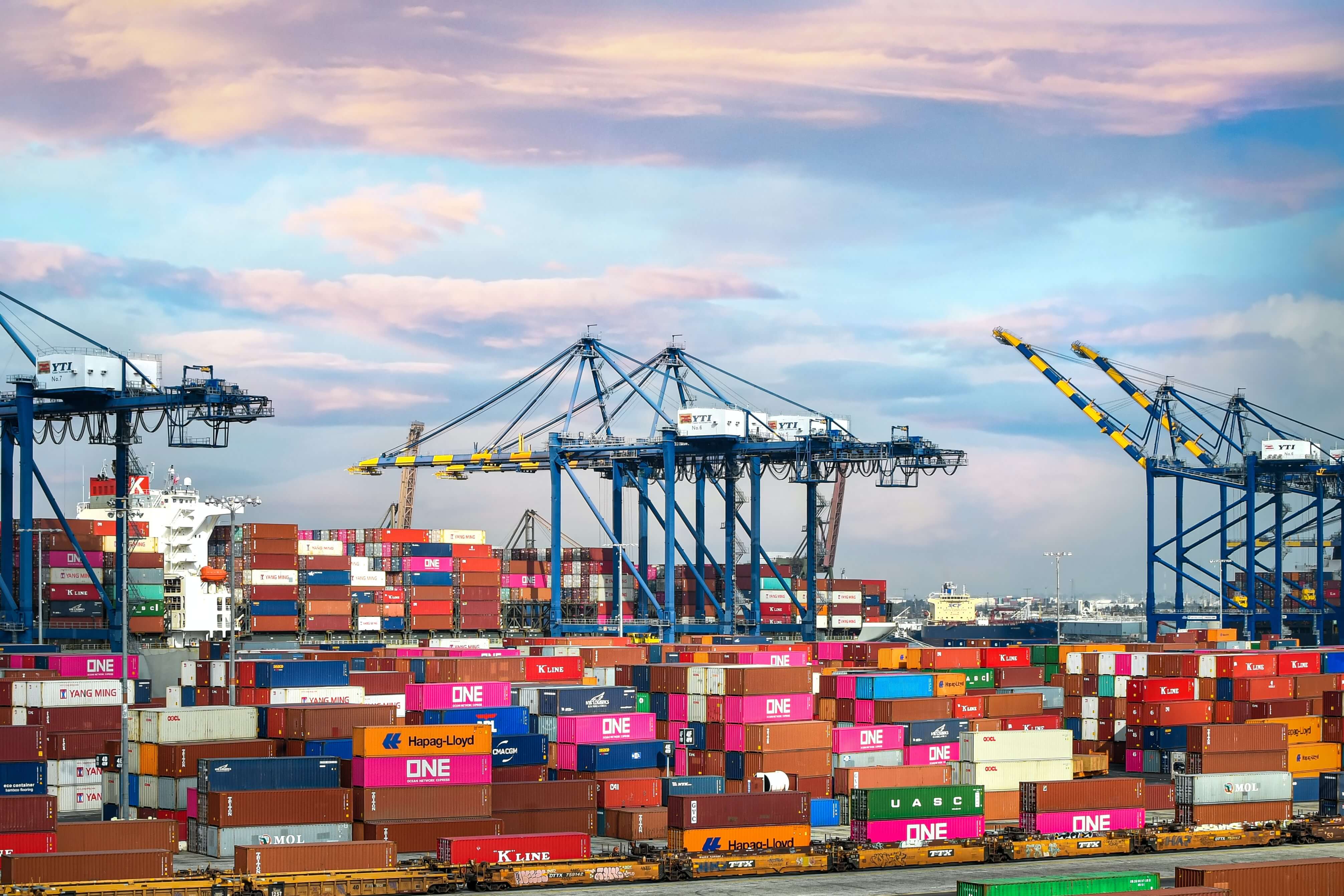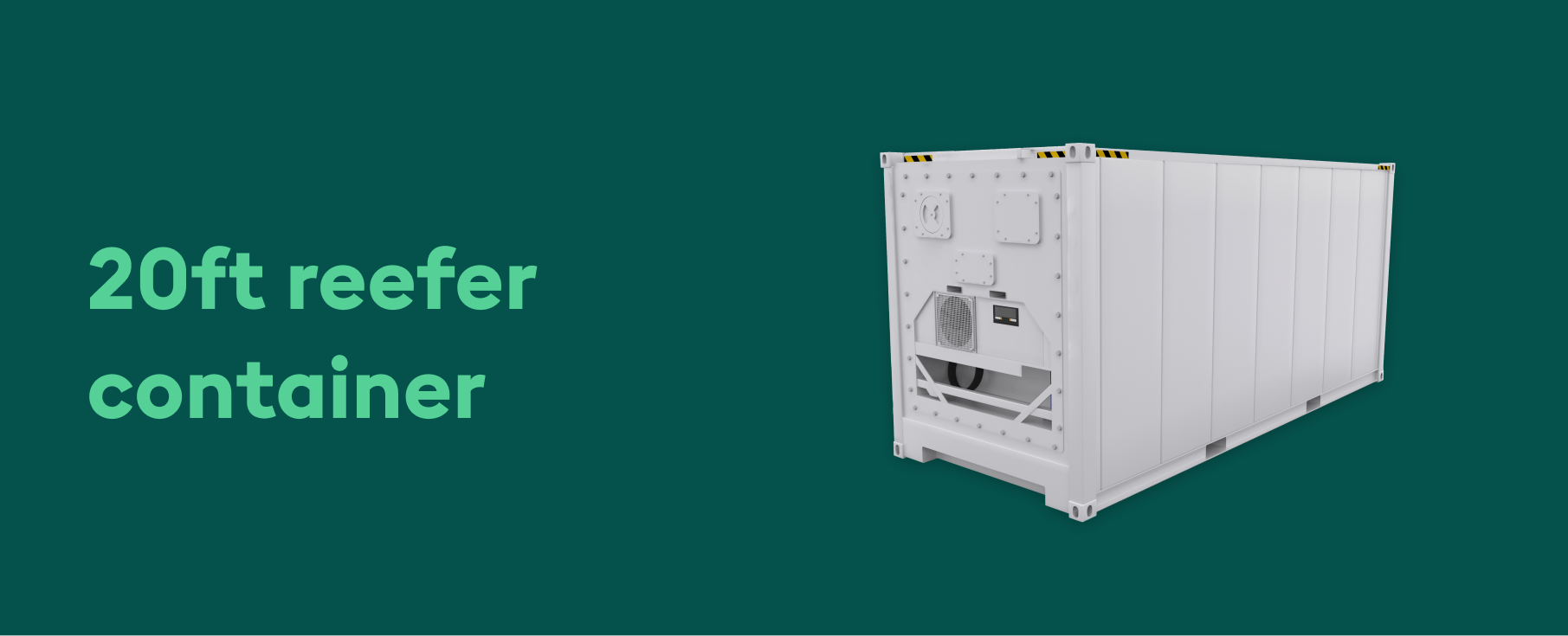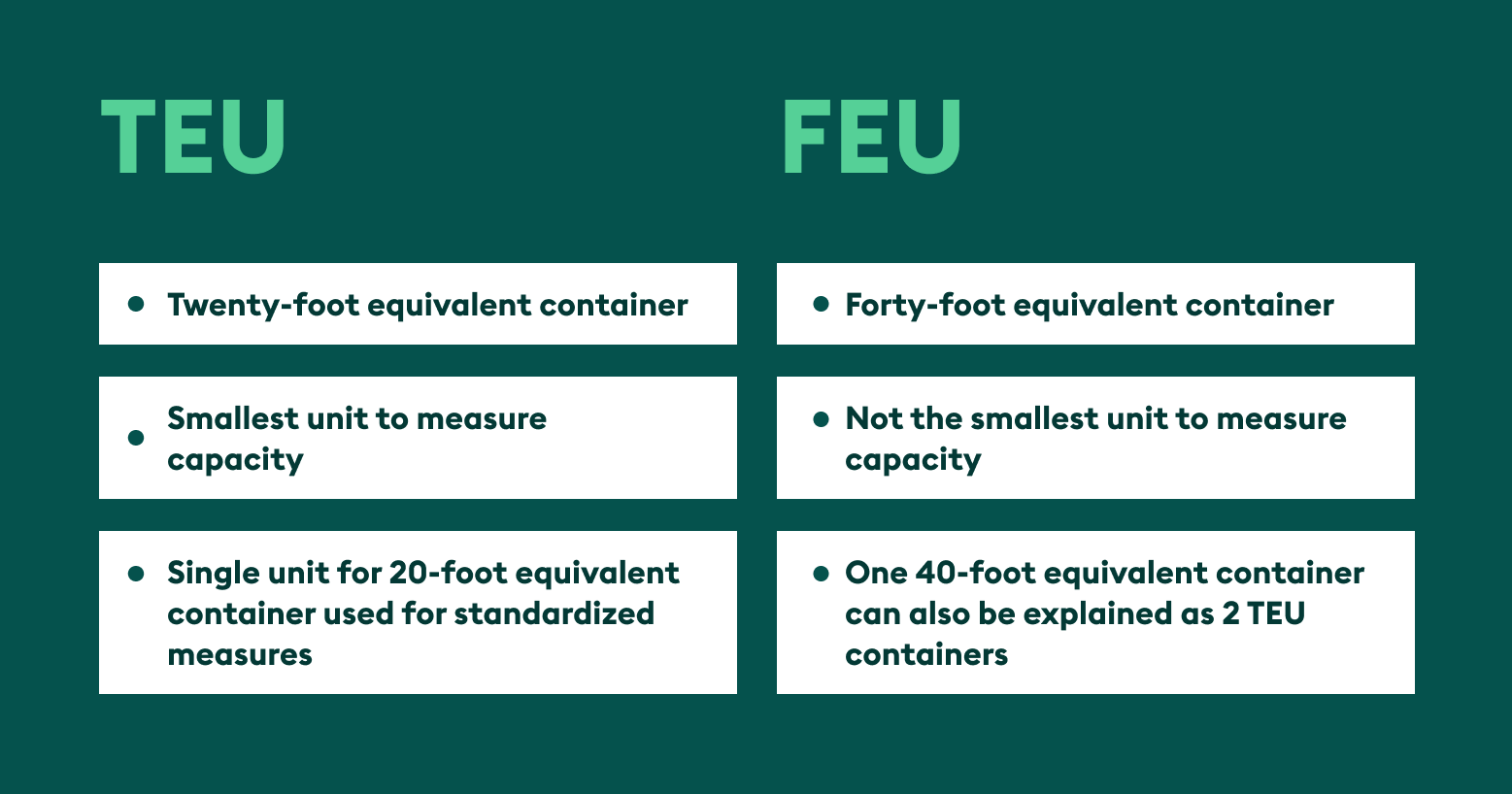If you’re wondering what a TEU container is and why it’s important, keep reading for the full lowdown. Plus, find out how to buy TEU containers from vetted suppliers at the best prices on Container xChange today.
The term ‘TEU’ or ‘Twenty-foot Equivalent Unit’ is first and foremost used to describe a 20ft shipping container. Over time, this has become a standard unit of measurement for cargo capacity in the logistics industry.
TEU containers allow cargo to be moved between various modes of transport including ships, trucks and trains seamlessly due to their standardized dimensions. We’ll get into more detail on this later on in the blog post.
If you already know what TEUs are and why they’re crucial in the shipping industry, let’s move on to figuring out how to buy shipping containers from reliable suppliers, at prices that fit your budget.
Luckily, we’ve got the perfect solution for you right here. Heard of Container xChange? We’re an online container marketplace for trading and leasing shipping containers including TEUs, with over 1,500 vetted industry members to work with. On our platform, you can choose from 50,000+ containers available in 2,500+ cities around the globe.
Why not try our platform for yourself right now? It’s so easy! Just type in the container type you need, plus your location, then hit ‘search’ to find offers that suit your criteria in no time at all.
What is a TEU container?
A TEU is the standard unit of measurement used in the shipping and logistics industry to quantify cargo capacity for container ships and terminals. The measurement for a TEU is based on the capacity of a 20ft intermodal shipping container.
And since container ships and terminals only accommodate intermodal containers (20ft and 40ft containers), they use TEUs as a benchmark to calculate their own capacity for handling and storing containers.

Understanding TEU containers is essential for efficient global shipping as these containers are vital for transporting goods worldwide. But where do you source TEUs at the best rates? Right here on Container xChange.
Our marketplace provides a broad range of shipping containers for sale, including options to popular US locations like Texas. Browse our large inventory of shipping containers for sale Houston, amongst other major ports. Whether you need new, used, or customized containers, Container xChange offers solutions tailored to your needs and budget. Choose from 100,000+ containers today!
TEU container dimensions and capacity
The TEU (20ft) container is used to transport smaller shipments of dry cargo, including pallets, boxes, clothing, electronics and grains. Here are the measurements of this container size:
| Measure | TEU shipping container |
| Internal length | 5.9m / 19.4ft |
| Internal width | 2.35m / 7.8ft |
| Internal height | 2.39m / 7.9ft |
| Tare weight | 2,300kg / 5,071.5 lbs |
| Payload capacity | 25,000kg / 55,126.9 lbs |
| Cubic capacity | 33.2 m3 / 1,172 cu ft |
Want to know more about the nifty TEU shipping container, it’s benefits and uses? Learn all about this lightweight container size right now.
The importance of TEUs at shipping ports and terminals
So we’ve touched on the fact that TEU containers allow for standardization in the shipping industry. But how does this actually come into play at ports and terminals? Let’s learn more now.
Capacity planning: Using the TEU system allows for efficient capacity planning at shipping ports and terminals. Having standard measurements for container types helps port authorities and operators to determine which type of machinery, infrastructure and port personnel are needed based on the capacity of cargo being handled.
Cargo stowage and optimization: Using TEUs also means more efficient stowage on ships and storage at terminals. Because of their specific sizes, containers can be stacked uniformly one on top of the other, maximizing space. This also minimizes the risk of damage and makes moving cargo safer.
Intermodal coordination: Using TEUs allows for the smooth transition of cargo between various modes of transport. Containers can be moved between trucks, trains and ships without needing to be unloaded first, saving both time and money.
Data tracking and planning: TEU data makes it easier for port authorities and industry players to track cargo volumes over specific periods of time. What’s more, they can identify trends and plan for the expansion and improvement of various shipping operations.
Documentation and customs clearance: TEUs simplify both customs procedures and shipping document handling. This is because having standard container sizes makes inspections and processing paperwork easier. This in turn improves the overall process flow and helps to reduce delays, saving money and keeping stakeholders happy – it’s win-win!

Curious about how TEUs became the standard unit of measurement in the shipping industry? Let’s learn about the invention of the shipping container now.
How TEU shipping containers became a key metric for the shipping industry
The concept of standardizing shipping containers dates way back to the 1950s when Malcolm McLean, an American trucking entrepreneur, decided to tackle the inefficiencies and complexities of traditional cargo handling.
After thinking long and hard about how to simplify the process, it dawned on him that there weren’t any standardized units used to carry cargo. So he came up with the idea of using steel boxes of specific dimensions for exactly this purpose. And there we have it, the birth of the shipping container!
Containers like these could be loaded directly onto both trucks and ships, eliminating the need to unload cargo as it changed between modes of transport. This increased efficiency and lowered costs, revolutionizing the entire shipping process.
In 1956, the world witnessed the successful implementation of McLean’s concept. Ideal-X, the world’s first container ship, embarked on its maiden voyage from New Jersey to Houston, carrying 58 TEUs.
This event marked the beginning of a shipping revolution, with the TEU rapidly becoming the standard unit of measurement for container capacity worldwide after this.
What is the TEU capacity of global shipping vessels?
TEUs are also commonly used to measure and categorize shipping vessels. For instance, large players in the industry own vessels with a carrying capacity of over 14,500 TEUs, while smaller feeder vessels can hold 1,000 TEU containers or less.
Now days, one of the most widely-used shipping vessels in the industry is called a Post-Panamax, with a TEU capacity of between 5,000 and 10,000. Post-Panamax vessels can range in length from 820ft to 984ft (250m to 299m). And then there’s Neo-panamax with a capacity of up to 14,500 TEUs.
The largest vessel types used regularly in the industry are called Ultra Large Container Vessels (ULCVs). ULCVs are as long as 300m (984ft) and have a TEU capacity of 14,000 or more. The largest container ship called MSC Irina, with a capacity of 24,346 TEUs, came into service in 2023 and is sailing under the Liberian Flag.
Apart from Post-Panamax and ULCV, you also get small feeder ships with a capacity of between 1,000 and 2,000 TEUs, Feedermax vessels with 2,000 to 3,000 TEUs and Panamax vessels with 3,000 to 5,000 TEUs.
How to calculate TEU?
To calculate TEU, you need to know the size of the containers being used and the number of containers. The most common container sizes are 20 feet and 40 feet. Here’s how you can calculate TEU:
- Identify Container Sizes: Standard containers are usually 20 feet (referred to as a 20-foot container) or 40 feet (referred to as a 40-foot container).
- Count the Number of Each Container Size: Count how many 20-foot containers (TEU) and how many 40-foot containers (2 TEU) you have.
- Calculate TEU: Multiply the number of 20-foot containers by 1 (since each 20-foot container is 1 TEU). Multiply the number of 40-foot containers by 2 (since each 40-foot container is 2 TEU). Add the results from the above two calculations to get the total TEU.
So, now that you’re up to speed about caluclating TEUs, let’s dive into the different types in the next section:
Different types of TEU containers
While the 20ft dry container may be the benchmark for measuring cargo capacity, there’s a wide range of other container types available in the shipping industry, each with particular benefits and uses. Let’s dive into some of these container types below.
20ft reefer container
Refrigerated containers, commonly known as reefers, are used to transport dairy, meat and other temperature-sensitive goods. They’ve got special cooling equipment which can maintain any temperature between 30 and -30 degrees Celsius.
20ft open top container
Open top containers are open at the top – perfect for over height cargo. Instead of a roof, a tarpaulin sheet is used to keep cargo protected.
20ft hard top container
Hard top containers have a hard detachable steel roof and are used to carry large construction materials, machinery and other tall cargo.
20ft side door container
A 20ft side door container has extra doors on one of the longer sides of the unit. This makes loading and unloading oddly-shaped and large items quick and convenient.
20ft flat-rack container
Flat-rack containers have no roof or walls on their longer sides. They’re perfect for large, awkwardly-shaped and over height cargo of various kinds. Lashing rings are used to secure cargo to this container type.
Interested in finding out the prices of the above container types? We’ve also got standard and special containers available in 40ft, 40ft high cube and 45ft high cube sizes.
On xChange, choose from 50,000 containers available in 2,500+ locations around the globe. Check out the prices of the container type you need, in the location you require right now by clicking on the banner below.
TEU container vs FEU container: What’s the difference?
As we’ve seen, a standard TEU is 20ft (6.1m) long, 8ft (2.4m) wide, and 8ft (2.4m) tall. A FEU (Forty-foot Equivalent Unit) is twice the size of a TEU, at 40ft (12.2m) long, 8ft (2.4m) wide, and 8ft (2.4m) tall.
It’s basically the older sibling of the 20ft, with double the capacity. However, it’s important to note that buying one 40ft container is usually cheaper than buying two 20ft units.
We use the terms TEU and FEU to describe the capacity of cargo. For example, if you have two 20ft containers and one 40ft container, your shipment is considered to be four TEUs, or two FEUs in total.
Here’s a quick summary of the main differences between TEUs and FEUs:
Keep up-to-date with TEU and FEU container prices for free
Interested in buying TEUs or FEUs? Then it’s important to keep your finger on the pulse when it comes to container prices and trends. Welcome to xChange Insights, where you can access container trading and leasing data in over 180 locations anytime, from anywhere.
On our Insights platform, find price data for new and used 20ft and 40ft dry containers in the locations you need. Use this tool to track price changes and trends, as well as to pinpoint the cheapest locations to buy containers in, and the most lucrative areas to sell them in to make a profit.
Insights equips you with all the data you need for ultimate trading negotiation power. With access to the most recent price information, you’re in the perfect position to spot good deals as soon as they appear.
Plus, you’ll know when asking prices are too high and you need to negotiate them down. So you can avoid getting overcharged for containers!
Want to know the best part about Insights? You can use it completely free – no commitment, no costs involved! Start making smart trading and leasing decisions for your business today.
Buy TEU containers at the best prices on Container xChange
Ready to keep up-to-date with container prices, and get the best deals for your budget quickly and easily, all from the comfort of your office? Then it’s time to sign up as a member on Container xChange.
Here are a few of the benefits you’ll get as a member:
- Safe and efficient payment handling right on the platform with the xChange Wallet
- 50,000+ containers available to buy and lease in over 2,500 cities around the world
- Deal directly with vetted suppliers, no middlemen
- 0% commission on deals & no hidden fees
Get started today by signing up for a free demo of our platform. You’ll get a sneak peek of how Container xChange works, as well as the opportunity to ask important questions about how our marketplace can work for your business. So what are you waiting for? Click below to learn all about buying TEUs at the best prices today.
TEU containers: Common FAQs
What is a TEU container?
TEU stands for ‘Twenty-foot Equivalent Unit’. It is the standard unit of measurement used in the shipping industry to quantify the capacity of container ships and container terminals.
How much is a TEU in meters?
A Twenty-foot Equivalent Unit (TEU) is a standard 20ft dry shipping container. This container is approximately 20ft (6.1m) long, 8ft (2.4m) wide, and 8ft (2.4m) tall.
How is the TEU of a container calculated?
First, measure the length. For example, for a 40ft container, the length would be 40ft (12.2m). Then divide the length by the standard length of a TEU container: 40ft ÷ 20ft = 2. The result represents the number of TEUs the container is equivalent to. In this example, a 40ft container is equal to two TEUs.




